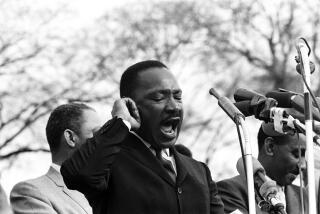Marching Orders : For First Time Since 1985, Camp Pendleton Unit Walks 100 Miles
- Share via
Sherman’s 56-day march through the South. Longstreet’s 150-mile march to Gettysburg. The revolutionary march by Mao.
And now the 100-mile march by 400 Marines from the 1st Marine Regiment from Lake Hemet to Camp Horno at Camp Pendleton, the first march that long by Marines from Camp Pendleton since 1985.
The 100-mile march--which required a 250-page environmental impact report filed with local governments--followed a zigzag course through private and public lands, led by a colonel whose name might be found under the definition of “gung-ho.”
“We’re infantry and our principal movement is by foot,” said Col. Peter Miller, who marched merrily at the head of the long column. “I have to take a 19-year-old from Southern California who has McDonald’s and Taco Bells and sports cars and pretty girls and then he’s meant to be a gunfighter. I give him a touch of reality.”
The march fits nicely into the drive by the Marine Corps commandant, Gen. Charles Krulak, to make Marine Corps training, already among the most physically demanding of any military service, even more arduous by adding more push-ups, more pull-ups, more running, and more of all sorts of things that make one’s muscles ache.
At Krulak’s insistence, the Marines are devising a grueling obstacle course--The Crucible--to be included in Basic Warrior Training. A few good men may become fewer, but they will become tougher.
When marching occurs, blisters or other unsavory foot, ankle, knee and leg conditions are sure to follow. Miller, a former British marine who retains his English accent, says the goal is for his troops to overcome such adversity with “mental toughness.”
“Probably 80% of the formation right now either have blisters or they are walking on bruised feet,” Miller said. “And there’s absolutely nothing you can do about it other than walk through it, and there’s where the mental part comes in.”
This, of course, is peacetime, and Miller has made some concessions. A 10-minute rest is provided every three miles. Corpsmen are available for blister care. A convoy trails behind with cooking equipment and portable toilets.
The march started Wednesday after the troops finished desert warfare training at the corps’ desert base at Twentynine Palms. After being trucked to Hemet, the Marines set out with full packs on a march that averaged 4 mph, with an hour for lunch and camping nightly in the open.
On Saturday, the Marines marched onto the far reaches of Camp Pendleton and are poised for the triumphant final 13 miles today. At a rest stop Friday in the wine country of Temecula in southern Riverside County, the talk turned quickly to feet and other points of pain.
Lance Cpl. David Avelar, who grew up in Garden Grove, figures that the 100-mile march “will give me bragging rights. I can go back and say I went on this march.”
Like many of his compatriots, he listens to music blared from the back of a truck while he marches, mostly country and western. “It keeps your mind off the pain, off of the walking,” he said.
Gunnery Sgt. Ward Warren is glad he took some precautions. Before the march, he went to a sporting goods store in Orange County where the clerk had just returned from an 11-mile walk in the South American rain forest without getting blisters or foot rot.
The clerk recommended a certain brand of no-blister socks. “I said, ‘I’ll take ‘em,’ ” Warren said. “I would have taken a lot more, but at $8.50 a pair, I couldn’t afford more than two pair.”
Lance Cpl. Thomas Kenney, who grew up in the San Fernando Valley, was on guard duty at the U.S. Embassy in London until recently. Marching was a bit of a shock.
“After a certain point, when you’re hurting, you’re mostly going just on heart and discipline and that’s all mental,” Kenney said. “The physical, you just have to put it out of your mind and keep going. We do that just by making each other laugh and joking around.”
Beyond toughening up his troops, Miller sees a benefit in letting the public see his Marines. One difference between England and the United States, Miller said, is that here, the military seems to keep out of sight, which Miller finds lamentable.
“You either read about it in the newspaper when a young Marine has done something silly, or you see us on CNN when we fly off to war or when we fly back again,” Miller said. “This is a way of exercising our right to march across the countryside and tell everybody: ‘Hey, young Marines bust their butts on a daily basis, take a look at us.’ ”
Whatever grousing there is in the ranks, the feeling among the brass and the noncommissioned officers is that it will disappear when the regiment reaches Camp Horno.
“Be there on the last day and you’ll see Marines walking 10 feet tall,” said Sgt. Maj. Charles Constance. “They’ll believe in this just as strongly as we do.”
More to Read
Sign up for Essential California
The most important California stories and recommendations in your inbox every morning.
You may occasionally receive promotional content from the Los Angeles Times.













